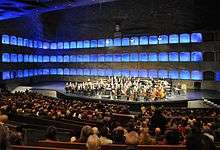Felsenreitschule
The Felsenreitschule (literally "rock riding school") is a theatre in Austria and a venue of the Salzburg Festival. [1]

It was built in 1693 under Archbishop Johann Ernst von Thun, designed by Johann Bernhard Fischer von Erlach in the quarry for conglomerate rock used in the new Salzburg Cathedral building. It was used as the archbishop's summer riding school and for animal hunts. The audience took place in the 96 arcade space that is created above the other three floors. Since 1926, the Felsenreitschule has been used for performances of the Salzburger Festspiele. The former audience arcades serve as a natural stage setting. The first production was Carlo Goldoni's The Servant of Two Masters, directed by Max Reinhardt. In 1933, Clemens Holzmeister designed for Max Reinhardt the "Faust Town", a multiple-stage setting for Reinhardt's legendary production of Goethe's Faust. In 1948 Herbert von Karajan used the Felsenreitschule for the first time as an opera stage for performances of Christoph Willibald Gluck's Orfeo ed Euridice. This was followed in 1949 by the premiere of Carl Orff's setting of the ancient tragedy Antigone by Sophocles, translated into German by Friedrich Hölderlin, conducted by Ferenc Fricsay. In the years 1968-1970, the Felsenreitschule was remodeled according to plans by Clemens Holzmeister and was inaugurated with Ludwig van Beethoven's Fidelio under the baton of Karl Böhm. The stage has a width of 40 metres (130 ft), and 4 metres (13 ft) understage. Also renovated was the cantilevered grandstand with the underlying scene dock. A light-tight, rain tarp to dampen the noise and protect the stage was also added. This roof can be opened.

The theater holds 1412 seats and 25 standing places. Between the summers of 2010 and 2011 festival, the roof was renewed: The new design added 700 square metres (7,500 sq ft) of floor space for equipment and rehearsal rooms. The new pitched roof consists of three mobile segment surfaces and is on five telescopic arms and can be extended and retracted in six minutes. Suspension points on telescopic supports for stage equipment (hoists), improved sound and heat insulation, and two lighting bridges optimize the action on stage. The Felsenreitschule shares its foyer with the Small Festival Hall ("House for Mozart").[2] [3]
The Felsenreitschule was used as a location in the 1965 film version of The Sound of Music. It is the site of the music festival from which the von Trapp family disappear. [4]
References
- ↑ "FELSENREITSCHULE: SALZBURG RIDING SCHOOL". Visit-Salzburg.net. Retrieved 25 September 2014.
- ↑ Hierl-Deronco, Norbert (2007). Theatrum equorum Salisburgensium Rösser, Reiter, Bauten des Barock und der Colloredo-Zeit. Krailling: Hierl-Deronco. ISBN 978-3-929884-11-1.
- ↑ "Felsenreitschule". Salzburger Festspiel. Retrieved 25 September 2014.
- ↑ "The Sound of Music film locations". The Worldwide Guide to Movie Locations. Retrieved 25 September 2014.
Coordinates: 47°47′54″N 13°02′30″E / 47.79833°N 13.04167°E